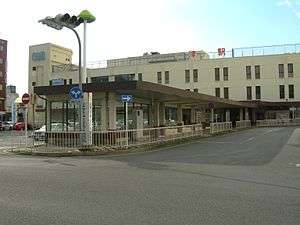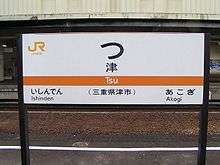Tsu Station
Tsu Station (津駅, Tsu-eki) is a joint use railway station in Tsu, Mie Prefecture, operated by Central Japan Railway Company (JR Central), Kintetsu and the Ise Railway. The station is 34.6 rail kilometres (21.5 mi.) from the terminus of the line at Kameyama Station and 8.4 rail kilometres (5.2 mi.) from the terminus of the Kintetestu Yamada Line at Ise-Nakagawa Station. The name of the station is considered the shortest in Japan because it is the only station name that is written with one kana, even though other stations have shorter names when written in Latin letters, such as Oe Station.
Tsu Station 津駅 | |
|---|---|
 Tsu Station east exit | |
| Location | 1191-1 Hadokoro-cho, Tsu, Mie (三重県津市羽所町1191-1(JR東海)) Japan |
| Operated by |
|
| Line(s) |
|
| Other information | |
| Station code | 12 (Ise Railway) |
| History | |
| Opened | 1891 |
| Traffic | |
| Passengers (FY 2016) | 3,411 (JR) 15,665 (Kintetsu) 1,815 (Ise Railway) daily |

History
Tsu Station opened on November 4, 1891, as a station on the Tsu spur line of the privately owned Kansai Railway. The line was nationalized on October 1, 1907, becoming the Sangu Line of the Japanese Government Railways (JGR) on October 12, 1909. On April 3, 1932, the Sangu Express Electric Railway began operations at Tsu Station. This line underwent various changes in ownership, eventually becoming the Kintetsu Nagoya Line in 1944. The station was transferred to the control of the Japan National Railways (JNR) Kisei Main Line on July 15, 1959. The JNR Ise Line began operations on September 1, 1973. The station was absorbed into the JR Central network upon the privatization of the (JNR) on April 1, 1987, with the Ise Line spun off to the private sector a few days earlier.
Lines
- Central Japan Railway Company (JR Central)
- Kintetsu
- Ise Railway
- Ise Line
Station layout
Tsu Station has four ground-level platforms serving six tracks, connected by pedestrian overpasses. The JR uses one island platform and one side platform and the Kintetsu portion has one island platform. The Ise Railway uses a single bay platform.
Platforms
| 1 | ■ Ise Railway Ise Line | local trains for Yokkaichi, via Suzuka |
| 2 | ■ JR Central Kisei Line | local trains, rapid " Mie" and limited express "Nanki" for Matsusaka, Shingu, Iseshi, Toba and Kii-Katsuura |
| 3 | ■ JR Central Kisei Line | local trains for Kameyama |
| ■ through to the Ise Railway Ise Line | rapid " Mie" and limited express "Nanki" for Yokkaichi and Nagoya | |
| 4 | ■ JR Central Kisei Line | local trains for Kameyama (siding) local trains for Matsusaka, Taki, Shingu, Iseshi and Toba (siding) |
| 5 | ■ Kintetsu Nagoya Line | for Ise-Nakagawa, Osaka, Kobe, Toba and Kashikojima |
| 6 | ■ Kintetsu Nagoya Line | for Yokkaichi, Kuwana and Nagoya |
Adjacent stations
| « | Service | » | ||
|---|---|---|---|---|
| JR Central Kisei Main Line | ||||
| Ishinden | Local | Akogi | ||
| Ise Railway Ise Line | Rapid "Mie" | Matsusaka | ||
| Ise Railway Ise Line | Limited Express "Nanki" | Matsusaka | ||
| Kintetsu Nagoya Line | ||||
| Edobashi | Local | Tsu-shimmachi | ||
| Edobashi | Express | Tsu-shimmachi | ||
| Shiroko | Limited Express | (Hisai) Ise-Nakagawa Nabari (Osaka Line) | ||
| Kintetsu Nagoya | Limited Express (no stops between Nagoya and Tsu) |
Iseshi (Yamada Line) (Yamato-Yagi) (Osaka Line) Tsuruhashi (Osaka Line) | ||
| Limited Express "Shimakaze": Does not stop at this station | ||||
| Ise Railway Ise Line (12) | ||||
| Higashi-Ishinden (11) | Local | Terminus | ||
| Suzuka Circuit Ino (6) (during racing events at Suzuka Circuit) Suzuka (4) |
Rapid "Mie" (usually) | Matsusaka (Kisei Line) | ||
| Nakaseko (8) | Rapid "Mie" 4, 6 for Nagoya | Matsusaka (Kisei Line) | ||
| Suzuka Circuit Ino (6) (during Formula 1 Japanese GP) Suzuka (4) |
Limited Express "Nanki" | Matsusaka (Kisei Line) | ||
External links
| Wikimedia Commons has media related to Tsu Station. |
- (in Japanese) Tsu Station Official home page - JR Central
- (in Japanese) Official home page – Kintetsu
- (in Japanese) Official home page - Ise Railway